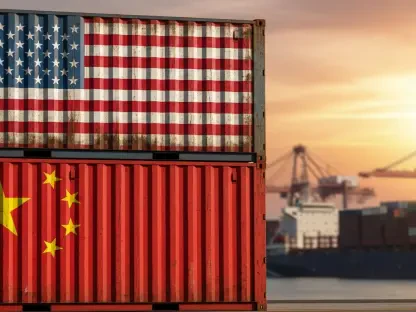The UK packaging sector is undergoing a profound transformation, with sustainability no longer a niche concern but a core market driver shaping the industry’s future. As environmental regulations tighten and consumer expectations for eco-friendly solutions soar, the industry faces a staggering challenge: how to balance economic viability with the urgent need for circular systems. Recent data reveals that while significant strides have been made in reducing problematic materials, the broader goal of a fully circular economy remains elusive. This market analysis explores the trends, challenges, and projections shaping the UK packaging landscape, focusing on the pivotal role of circularity and collaboration. It aims to provide stakeholders with actionable insights into current patterns and future opportunities, highlighting how systemic change can redefine profitability and environmental impact in this vital sector.
Market Trends and Data-Driven Insights
Evolution from Plastics Focus to Holistic Strategies
The UK packaging market has seen a marked shift in strategic priorities over recent years. Initially centered on reducing plastics through targeted initiatives, the industry now embraces a broader approach that encompasses all materials. This transition aligns with the waste hierarchy, emphasizing reduction and reuse over recycling. Industry reports indicate that past efforts successfully eliminated billions of problematic items and enhanced the recyclability of rigid packaging, yet the scope was limited. Today, the focus extends to comprehensive material management, with policies and frameworks pushing for systemic redesign. This evolution reflects a maturing market, where sustainability is increasingly integrated into core business models rather than treated as an add-on.
Economic Potential of Reusable Packaging Systems
A standout trend in the UK packaging market is the growing economic case for reusable systems. Data suggests that at scale, these systems can reduce costs by 10-20% compared to single-use alternatives, while cutting emissions and material usage by up to 95%. Sectors like online grocery delivery are proving particularly adaptable, leveraging existing return logistics to minimize operational friction. However, upfront infrastructure costs and consumer adoption barriers pose challenges to widespread implementation. Despite these hurdles, financial incentives through regulatory mechanisms are tilting the balance toward reuse, making it a compelling investment area for forward-thinking companies aiming to capture both cost savings and market goodwill.
Collaboration as a Market Differentiator
Collaboration stands out as a critical factor driving market innovation and growth. Cross-industry partnerships, facilitated by major industry events, bring together food producers, retailers, and waste management firms to tackle shared challenges. Historical data underscores the value of such alliances, showing substantial returns on investment when stakeholders unite around common goals. The current market environment builds on this legacy, with an expanded focus on diverse materials and integrated solutions. Yet, misaligned objectives and fragmented supply chains remain persistent obstacles. Companies that prioritize collaborative platforms gain a competitive edge, accessing shared expertise and accelerating the adoption of sustainable practices.
Data Transparency as a Market Enabler
Another defining trend is the urgent need for standardized data and transparency across the packaging supply chain. Inconsistent information on material origins—particularly for imported goods, where a significant portion remains untraceable—creates inefficiencies and hampers accountability. Digital tools and open-source platforms are emerging as solutions, offering real-time tracking and data-sharing capabilities. Market analysis indicates that addressing these transparency gaps is not merely a technical fix but a strategic imperative, enabling better decision-making and aligning industry efforts with regulatory and consumer expectations. Firms that invest in data infrastructure are likely to lead in compliance and operational efficiency.
Future Projections and Strategic Opportunities
Scaling Reuse through Technological Innovation
Looking ahead, the UK packaging market is poised for significant growth in reusable systems, driven by advancements in technology and logistics optimization. Projections suggest that digital tracking tools will become integral, streamlining material flows and reducing waste. The scalability of reuse models, particularly in high-volume sectors like e-commerce, could redefine cost structures over the next few years. However, achieving this potential requires overcoming the initial investment barrier and building consumer trust in return systems. Market leaders who prioritize pilot programs and partnerships will likely set the pace, capitalizing on early-mover advantages in a rapidly evolving landscape.
Policy as a Catalyst for Market Transformation
Regulatory frameworks are expected to play an increasingly influential role in shaping market dynamics. Policies such as Extended Producer Responsibility (EPR) are projected to expand, imposing stricter financial penalties on single-use packaging and incentivizing circular alternatives. Additional measures, like enhanced taxation on non-recyclable materials, could further shift economic incentives over the coming years, from 2025 to 2027. Consistency in enforcement will be critical to ensuring these policies drive meaningful change rather than mere compliance. Businesses that proactively align with anticipated regulations stand to mitigate risks and position themselves as industry frontrunners in sustainability.
Emerging Consumer Trends and Market Adaptation
Consumer behavior is another area of significant market influence, with growing demand for sustainable packaging solutions pushing companies to innovate. Recent trials demonstrate that households are willing to adapt to new systems, such as separating materials for recycling, when provided with clear guidance and accessible infrastructure. Forecasts indicate that this trend will intensify, with public pressure likely to accelerate corporate action. Companies that invest in consumer education and user-friendly reuse models can build brand loyalty while meeting regulatory demands. The intersection of consumer readiness and market innovation presents a unique opportunity for growth in the sustainable packaging segment.
Reflecting on Market Insights and Strategic Pathways
Looking back, this analysis of the UK packaging market revealed a sector at a critical turning point, where circularity and collaboration emerged as indispensable drivers of progress. The shift toward holistic sustainability strategies, underpinned by economic arguments for reuse and bolstered by cross-industry partnerships, painted a picture of an industry ready for transformation. Challenges such as data inconsistencies and infrastructure gaps were acknowledged as significant, yet surmountable with targeted investment and policy support. For stakeholders, the path forward involved embracing digital transparency tools to enhance supply chain efficiency and actively engaging in collaborative platforms to share best practices. A strategic focus on aligning with evolving consumer expectations and regulatory landscapes offered a roadmap to not only meet environmental goals but also unlock new market opportunities, ensuring long-term resilience and leadership in a sustainability-driven economy.









